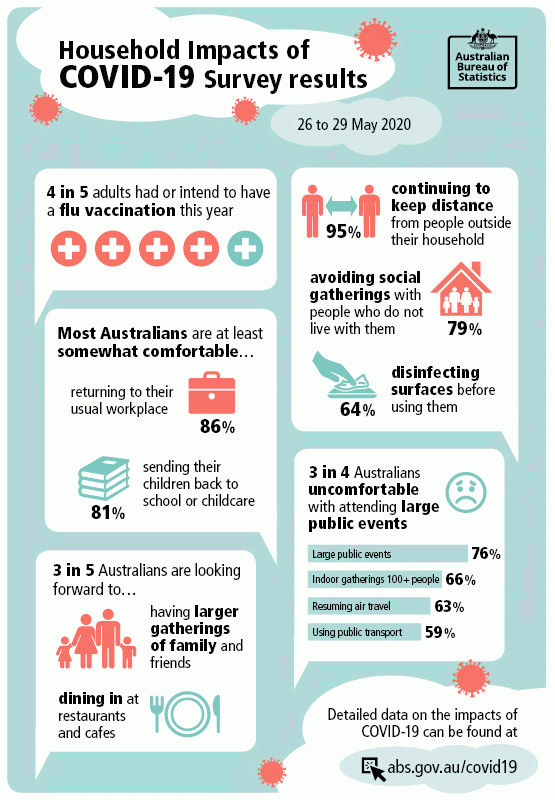This publication presents results from the fifth Household Impacts of COVID-19 Survey, a longitudinal survey which collects information from approximately 1,000 people fortnightly via telephone. This cycle was conducted between 26 May and 29 May 2020.
The fifth cycle collected information on:
- activity after relaxation of COVID-19 restrictions
- flu vaccinations
- health precautions taken in response to COVID-19
- time spent on activities (including activities at the same time as caring for children)
- job status
- education and skills development.
The scope of the survey was persons aged 18 years and over in private dwellings across Australia (excluding very remote areas).
About this collection
This survey is designed to provide a quick snapshot about how Australian households are faring in response to the changing social and economic environment caused by the COVID-19 pandemic. Each cycle has collected information on different topics.
Results from the earlier Household Impacts of COVID-19 Surveys can be found using the links below:
- Household Impacts of COVID-19 Survey 1–6 Apr 2020 (released 20 Apr)
- Household Impacts of COVID-19 Survey 14–17 Apr 2020 (released 1 May)
- Household Impacts of COVID-19 Survey 29 Apr–4 May 2020 (released 18 May)
- Household Impacts of COVID-19 Survey 12–15 May 2020 (released 29 May).
At the time of the survey, initiatives in place to help reduce the spread of COVID-19 and support the economy included:
- international travel restrictions
- an economic stimulus package (12 March)
- border control measures for some states and territories
- shutting down of non-essential services and a second economic stimulus package (22 March)
- a safety net package of $1.1 billion to expand mental health and tele-health services, increase domestic violence services and provide more emergency food relief (29 March)
- social distancing rules and additional shutdown restrictions (20–30 March)
- free childcare for working parents (2 April)
- a JobKeeper payment passed in legislation on 15 April, to keep more Australians in jobs and support businesses affected by the COVID-19 restrictions
- easing of restrictions on elective surgery gradually from 28 April
- National Cabinet agreeing on a three-stage plan to ease restrictions (8 May)
- easing of restrictions in all states and territories from mid-May, with some entering stage 2 at the time of the survey allowing visiting, larger gatherings and reopening of services.
Proportions marked with an asterisk (*) have a margin of error >10 percentage points which should be considered when using this information. For more information about margin of error refer to the publication Methodology.
